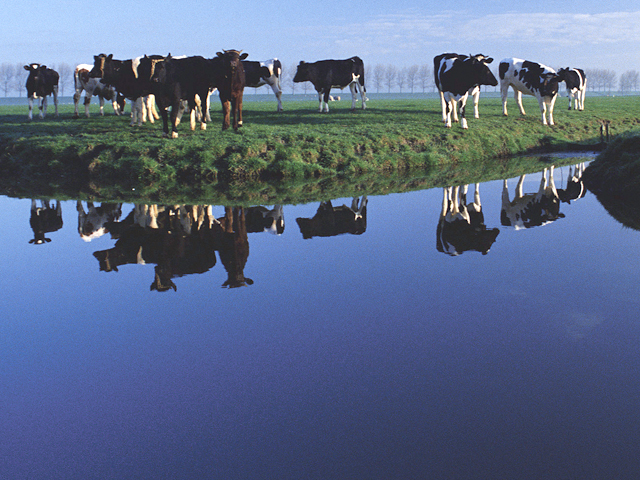Court Considers Water Rule Injunction
Intermittent Tributaries, Non-Navigable Wetlands Concern Cattle Group
OMAHA (DTN) -- A federal court in New Mexico could decide at any time whether to grant a preliminary injunction against parts of the Navigable Waters Protection Rule.
Lawyers in the case have completed all briefs on the motion for injunction, in a lawsuit challenging portions of the rule on intermittent tributaries and non-abutting wetlands as overreaching.
Back in May the New Mexico Cattle Growers Association asked for a preliminary injunction against parts of the rule, alleging farmers and ranchers face potentially "crippling liability" as a result of the rule taking effect.
The cattle producers argue the new rule from EPA and the Army Corps of Engineers will force ranchers to "spend months to years, and tens to hundreds of thousands of dollars, to obtain Army permits to farm and otherwise use their own land."
The group wants the U.S. District Court for the District of New Mexico to stop EPA and the U.S. Army Corps of Engineers from enforcing as jurisdictional intermittent tributaries and "non-navigable" wetlands if they don't abut navigable waters.
Tony Francois, senior attorney for the Pacific Legal Foundation representing the cattle producers, told DTN the federal court does not generally hold hearings on motions for injunction and could release a ruling "at any time."
On June 23, attorneys for the EPA and the Corps of Engineers opposed the motion for injunction, arguing the new rule has cleared up ambiguities in the definitions of waters of the United States.
P[L1] D[0x0] M[300x250] OOP[F] ADUNIT[] T[]
"Plaintiff also fails to meet the high bar of showing imminent, irreparable harm upon the effective date of the rule," the agencies argue.
"Plaintiff presents only vague allegations of unspecified activities that may be subject to regulation under the NWPR in waters that may or may not be jurisdictional. Plus, the public and governments will receive more benefits from replacing the 'significant-nexus' standard."
On June 30, intervenors opposed to the motion for injunction, including Amigos Bravos, New Mexico Acequia Association, and Gila Resources Information Project, argued in a brief the cattle producers have not proven "evidence of actual, imminent harm" from the rule.
"Among other things, the so-called 'Navigable Waters Protection Rule' strips the act's protections from at least 5 million stream miles and tens of million acres of wetlands nationwide," the water interest groups argued in their brief.
"In New Mexico, the rule eliminates protections for up to 90% of the state's currently jurisdictional waters, which will 'drastically and adversely impact the quality' of New Mexico's scarce water resources."
In a July 14 brief filed by the cattle group supporting an injunction, the group argued the new rule targets land features producers see on a daily basis.
"The agencies contend that cattle growers' claims against the two challenged provisions are not ripe because there is no catalog of projects with timetables presented with the motion," the cattle producers argued.
"This is incorrect. Cattle growers' declarations establish that intermittent tributaries and non-abutting wetlands are common features on member farms and ranches throughout New Mexico. The declarations also show that cattle growers' members frequently perform regulated activities in these features that are regulated by the rule. As a result of this combination of regulated water features and regulated activities, cattle growers members are subject to the challenged provisions of the rule now, not in some speculative future."
The New Mexico Cattle Growers Association makes the case the U.S. Supreme Court has already ruled in Rapanos v. United States, that similar provisions in prior regulations went beyond the scope of the Clean Water Act.
In 2007, the plurality on the Supreme Court held waters of the United States could only refer to "relatively permanent, standing or flowing bodies of water" and not "occasional," "ephemeral" or "intermittent" flows.
The cattle group originally filed a lawsuit in November 2019 challenging the 1986 regulation. The challenge came after the EPA finalized a repeal of the 2015 rule, because the repeal reverted back to the 1986 rule until the most recent rewrite was completed.
The amended lawsuit alleges the 1986 and 2020 rules are "arbitrary and capricious, and contrary to law, in violation of the Administrative Procedure Act."
The group said in its lawsuit that both the 1986 and 2020 definitions contain an "overbroad and illegal" definition of the navigable waters.
Last year, the South Carolina Coastal Conservation League, Natural Resources Defense Council, National Wildlife Federation and others filed a lawsuit in the U.S. District Court for the District of South Carolina challenging the repeal of the 2015 rule.
Todd Neeley can be reached at todd.neeley@dtn.com
Follow him on Twitter @toddneeleyDTN
(c) Copyright 2020 DTN, LLC. All rights reserved.




